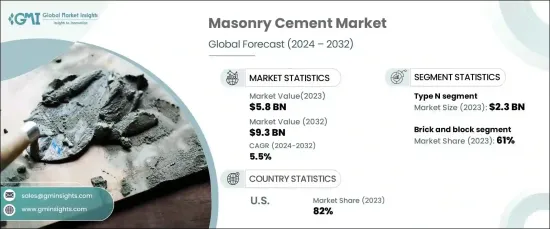PUBLISHER: Global Market Insights Inc. | PRODUCT CODE: 1664864

PUBLISHER: Global Market Insights Inc. | PRODUCT CODE: 1664864
Masonry Cement Market Opportunity, Growth Drivers, Industry Trend Analysis, and Forecast 2024 - 2032
The Global Masonry Cement Market reached a valuation of USD 5.8 billion in 2023 and is projected to grow at a CAGR of 5.5% between 2024 and 2032. This impressive growth trajectory is fueled by rapid urbanization and the increasing demand for high-quality construction materials, driven by a surge in global infrastructure development.

The market is segmented into Type S, Type N, Type M, and Type O masonry cement. Among these, Type N cement led the pack, generating USD 2.3 billion in 2023. It is projected to grow at a robust CAGR of 5.7% during 2024-2032. Renowned for its versatility and adaptability, Type N cement is widely used in residential construction projects such as walls, chimneys, and general masonry applications. As urban development accelerates-particularly in emerging markets-the need for affordable housing solutions continues to rise, bolstering demand for Type N cement. Its utility in standard construction tasks, such as bricklaying and mortar repairs, positions it as an essential component in the construction industry's toolkit.
| Market Scope | |
|---|---|
| Start Year | 2023 |
| Forecast Year | 2024-2032 |
| Start Value | $5.8 billion |
| Forecast Value | $9.3 billion |
| CAGR | 5.5% |
By application, the market is divided into brick and block construction, stone masonry, plastering, and others. In 2023, brick and block construction emerged as the dominant segment, accounting for a 61% market share, with a projected CAGR of 5.7% through 2032. This construction method is favored for its cost-effectiveness and durability, making it a popular choice across residential, commercial, and industrial projects. The growing demand for urban housing in regions such as Asia-Pacific, Africa, and Latin America is a key driver of masonry cement usage in brick and block construction.
The U.S. masonry cement market held a commanding 82% share in 2023, fueled by urban expansion and population growth in metropolitan and suburban areas. The country's rising construction activities, encompassing both residential and commercial projects, are driving the demand for masonry cement. Brick and block construction, in particular, plays a significant role in this growth, catering to the increasing need for durable and efficient building materials.
Table of Contents
Chapter 1 Methodology & Scope
- 1.1 Market scope & definitions
- 1.2 Base estimates & calculations
- 1.3 Forecast calculations.
- 1.4 Data sources
- 1.4.1 Primary
- 1.4.2 Secondary
- 1.4.2.1 Paid sources
- 1.4.2.2 Public sources
Chapter 2 Executive Summary
- 2.1 Industry synopsis, 2021-2032
Chapter 3 Industry Insights
- 3.1 Industry ecosystem analysis
- 3.1.1 Factor affecting the value chain.
- 3.1.2 Profit margin analysis.
- 3.1.3 Disruptions
- 3.1.4 Future outlook
- 3.1.5 Manufacturers
- 3.1.6 Distributors
- 3.2 Supplier landscape
- 3.3 Profit margin analysis.
- 3.4 Key news & initiatives
- 3.5 Regulatory landscape
- 3.6 Impact forces
- 3.6.1 Growth drivers
- 3.6.1.1 Increasing construction activities
- 3.6.1.2 Rapid urbanization
- 3.6.2 Industry pitfalls & challenges
- 3.6.2.1 Market saturation and intense competition
- 3.6.2.2 Sustainability concerns
- 3.6.1 Growth drivers
- 3.7 Growth potential analysis
- 3.8 Porter’s analysis
- 3.9 PESTEL analysis
Chapter 4 Competitive Landscape, 2023
- 4.1 Introduction
- 4.2 Company market share analysis
- 4.3 Competitive positioning matrix
- 4.4 Strategic outlook matrix
Chapter 5 Market Estimates & Forecast, By Type, 2021-2032 (USD Billion) (Kilo Tons)
- 5.1 Key trends
- 5.2 Type N
- 5.3 Type S
- 5.4 Type M
- 5.5 Type 0
Chapter 6 Market Estimates & Forecast, By Application, 2021-2032 (USD Billion) (Kilo Tons)
- 6.1 Key trends
- 6.2 Brick and block construction
- 6.3 Stone masonry
- 6.4 Plastering
- 6.5 Others (paving, etc.)
Chapter 7 Market Estimates & Forecast, By End Use, 2021-2032 (USD Billion) (Kilo Tons)
- 7.1 Key trends
- 7.2 Residential
- 7.3 Commercial
- 7.4 Industrial
Chapter 8 Market Estimates & Forecast, By Distribution Channel, 2021-2032 (USD Billion) (Kilo Tons)
- 8.1 Key trends
- 8.2 Direct
- 8.3 Indirect
Chapter 9 Market Estimates & Forecast, By Region, 2021-2032 (USD Billion) (Kilo Tons)
- 9.1 Key trends
- 9.2 North America
- 9.2.1 U.S.
- 9.2.2 Canada
- 9.3 Europe
- 9.3.1 UK
- 9.3.2 Germany
- 9.3.3 France
- 9.3.4 Italy
- 9.3.5 Spain
- 9.3.6 Russia
- 9.4 Asia Pacific
- 9.4.1 China
- 9.4.2 India
- 9.4.3 Japan
- 9.4.4 South Korea
- 9.4.5 Australia
- 9.5 Latin America
- 9.5.1 Brazil
- 9.5.2 Mexico
- 9.6 MEA
- 9.6.1 UAE
- 9.6.2 Saudi Arabia
- 9.6.3 South Africa
Chapter 10 Company Profiles
- 10.1 Ambuja Cements
- 10.2 Anhui Conch
- 10.3 Birla
- 10.4 Buzzi Unicem
- 10.5 Cemex
- 10.6 China National Cement Corporation
- 10.7 CRH
- 10.8 Dangote Cement
- 10.9 Heidelberg
- 10.10 Holcim
- 10.11 J.K. Cement
- 10.12 Siam Cement
- 10.13 Sinoma
- 10.14 Taiheiyo
- 10.15 UltraTech Cement




